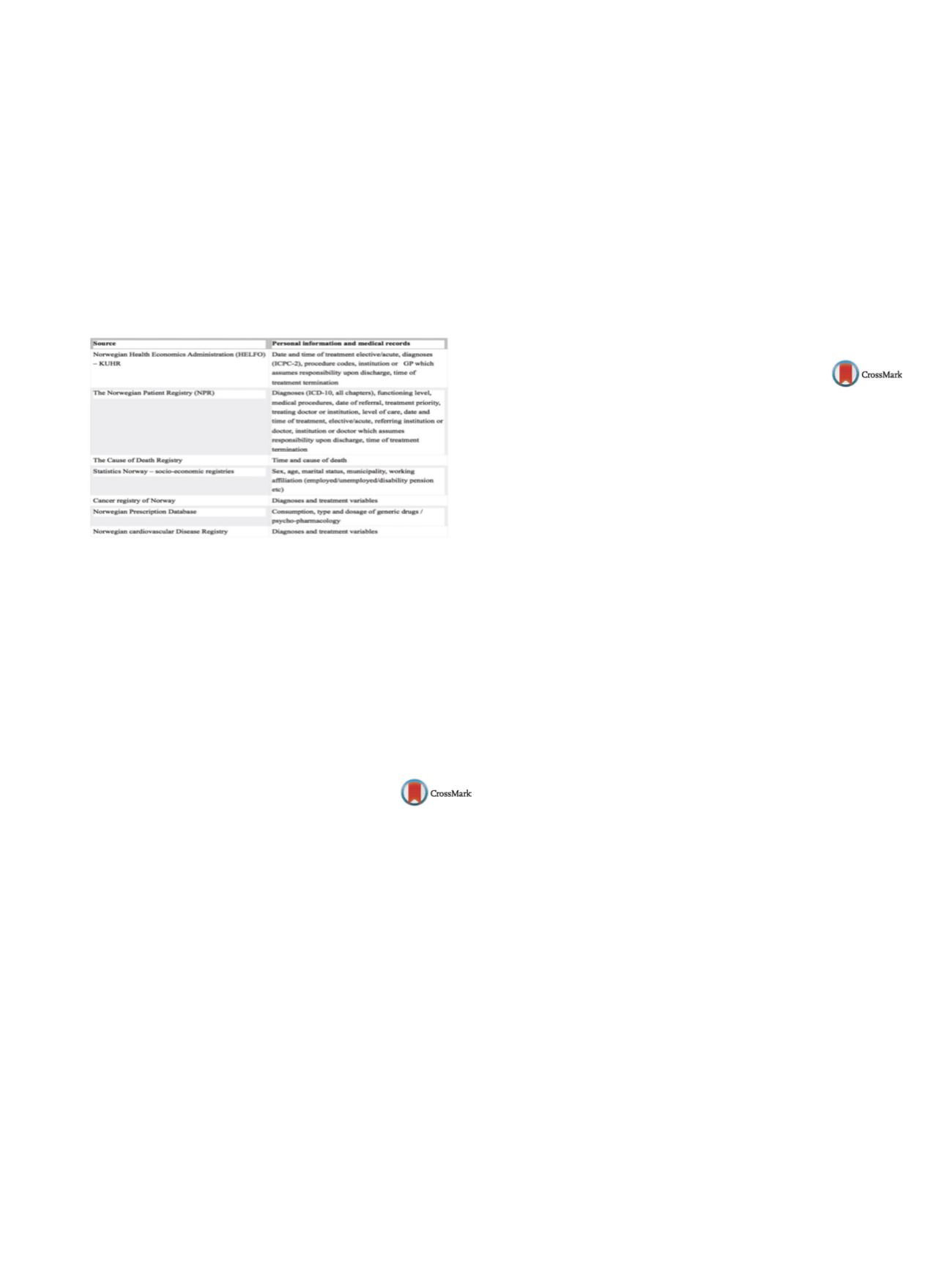

25th European Congress of Psychiatry / European Psychiatry 41S (2017) S465–S520
S481
– 3 Comorbidity of cancer and psychiatric illness: Findings from
North Norway.
– 4 Cardiovascular disease is prevalent among people suffering
from depression and anxiety.
– 5 The importance of the use of antipsychotic medication for phys-
ical health.
– 6 Coercion and general health among psychiatric patients. The
importance in continuity of care.
– 7 Substance-use among psychiatric patients. Implications for gen-
eral health and care pathways.
– 8 Psychiatric patients use of general practitioner medical treat-
ment.
Table 1
An overview of the information that will be retreived from
the registries.
Disclosure of interest
The authors have not supplied their decla-
ration of competing interest.
References
[1] Walker ER, McGee RE, Druss BG. Mortality in mental disorders
and global disease burden implications: a systematic reviewand
meta-analysis. JAMA Psychiatry 2015;72:334–41.
[2] Reininghaus UR, et al. Mortality in schizophrenia and other psy-
choses: a 10-year follow-up of the SOP first-episode cohort.
Schizophr Bull 2015;41:664–73.
http://dx.doi.org/10.1016/j.eurpsy.2017.01.565EV0236
Psychopathological consequences of
introducing psychopharmacological
treatment in patients with ADH with
comorbidrug use. A preliminary study
L.A. Nú˜nez Domínguez
1 ,∗
, O. Arbeo Ruiz
2, L. Barrado Los Arcos
31
Centro médico, psychiatry, Pamplona, Spain
2
Centro de Día Zuría, psychiatry, Pamplona, Spain
3
Mental health net, psychaitry, Pamplona, Spain
∗
Corresponding author.
Introduction
There exists a high prevalence of SUD among
patients suffering ADHD and the consequences of this comorbid-
ity are that AHDH and SUD may exacerbate the outcome of SUD
and vice versa. The presence of both disorders increases the risk of
chronicity and the level and/or the number of symptoms.
Themain objective is to evaluate how the introduction of treatment
correlates with a better control of symptoms.
Material and methods
We select a group of patients with both
diagnosis treated in aMental HealthDay Center in Pamplona, Spain.
We employ several scales to evaluate the sample: SCL-90, SF-36,
Weiss Scale and a Scale of Satisfaction, in three times: at the begin-
ning, one month and three months. We employ urinalysis to detect
level and number of substances.
Results
The sample is comprised by 12 patients, main age of 42.6
years. 8 patients are cocaine addicts. The majority received Atom-
oxetine (main dosage 36.0mg)
Our data shows an important decrease in the score of Neurotics
groups of symptoms and Hostility. We observe a decrease in score
of items correlated with physic health and an increase in emotional
aspects of daily life.
Eight patients gets abstinence and the punctuation of craving
decrease from 21 to 5.2.
The level of satisfaction with treatment was very high.
Conclusions
The psychopharmacological treatment of patients
diagnosed of ADHD with comorbid SUD implies a great improve-
ment in the symptomatology and quality of life of the patients, with
a low level of craving.
Disclosure of interest
The authors have not supplied their decla-
ration of competing interest.
http://dx.doi.org/10.1016/j.eurpsy.2017.01.566EV0237
Life is in the air: Inhalated methanol
poisoning. A case report
N.I. Nú˜nez Morales
1 ,∗
, M. Gómez Revuelta
1,
G. Montero González
2, M. Zubia Martín
1, L. García Ayala
1,
C. Martín Requena
1, N. Gómez-Coronado Suárez de Venegas
3,
C. Gómez Sánchez Lafuente
4, P. Pérez Martínez de Arrieta
1,
A.M. González-Pinto Arrillaga
11
Hospital universitario de Álava, psychiatry, Vitoria, Spain
2
Hospital Zamudio, psychiatry, Zamudio, Spain
3
Hospital universitario Virgen del Rocío, psychiatry, Sevilla, Spain
4
Hospital universitario Virgen de la Victoria, psychiatry, Malaga,
Spain
∗
Corresponding author.
Introduction
Methanol poisoning is uncommon but potentially
lethal. The way of poisoning is usually oral. However, in a small
number of cases, inhalated methanol poisoning was described.
Most of these occurred among patients suffering a disorder by use
of this substance. This type of poisoning has an insidious presenta-
tion, that complicates its diagnosis. This poisoning may be lethal.
It may produce a chronic and severe affectation of the central ner-
vous system in those who survive to the poisoning. After diagnosis,
it is compulsory to act quickly, and it often requires advanced vital
support and hemodialysis.
Objectives
Educate the Mental Health professionals about a type
of disorder by consumption increasingly more frequent in some
cities across Europe. This is a high fatality related poisoning that
emergency and general psychiatrists should know as it is increas-
ingly common in Europe.
Methods
We present the case of a 20-year-old patient, treated at
the emergency department of our hospital in context of metanol
inhalation. The patient regularly attended to our Dual Pathology
outpatient unit due to a severe inhalant use disorder. Several stays
at the intensive care unit had been recorded and he already pre-
sented with severe optic nerve affectation.
Discussion
In recent years there has been an increase in inhalant
abuse in Europe, which is still underestimated by our poor knowl-
edge about its potential toxicity.
Conclusion
Inhalated methanol poisoning occurs with a typical
presentation, andmay appear after suicide trial or overdose. Mental
health professional should become aware of its potential lethality
to approach properly to these patients.
Disclosure of interest
The authors have not supplied their decla-
ration of competing interest.
http://dx.doi.org/10.1016/j.eurpsy.2017.01.567

















